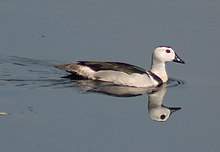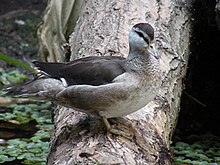Coromandel pygmy duck
| Coromandel pygmy duck | ||||||||||||
|---|---|---|---|---|---|---|---|---|---|---|---|---|

Coromandel pygmy ducks, male |
||||||||||||
| Systematics | ||||||||||||
|
||||||||||||
| Scientific name | ||||||||||||
| Nettapus coromandelianus | ||||||||||||
| ( Gmelin , 1789) |
The Coromandel pygmy duck ( Nettapus coromandelianus ) is a species of duck bird and one of the swimming ducks . Their range extends from Southeast Asia to Australia. It is one of the smallest species of duck. There are two subspecies. The nominate form Nettapus coromandelianus coromandelianus , which is also known as the Indian pygmy duck , is limited in its distribution to Asia. The Australian coromandel dwarf ( N. c. Albipennis ) lives in eastern Australia. The nominate form is slightly smaller than the Australian subspecies and is considered the smallest duck at all.
Appearance
When fully grown, dwarf ducks reach a length of between 30 and 37 centimeters. Males reach an average weight of 403 grams, the females are only slightly lighter with an average of 380 grams. However, very small females sometimes only weigh a little more than 250 grams. When resting, the males resemble the females. The chest band is missing at this time. However, they keep their wing color and also have a white head during this period. The back is dull black.
The male of the Coromandel pygmy duck has green coat plumage and a narrow, black chest band. The slightly angular head is black on the top. The face is white. The under tail cover is black. The short beak is dark gray. The legs and feet are olive gray. The eyes are red. The females have a striking rein streak. The black head plate is more extensive than that of the female. The face is generally a little gray or cream-colored. The cloak plumage is a bit browner, the eyes are not so noticeably reddish and the underside of the body is dull, light gray. The wings of the females are solid brown. Fledglings are like females in their plumage. In contrast to the female, however, the head and neck are more densely interspersed with brown feathers.
The chicks are gray-brown on top and have large, white spots on the shoulders, wings and sides of the body. The headstock is black. The face is light. You have a long, dark streak of eyes.
Possible confusion with other species
In their natural range, Coromandel pygmy ducks can hardly be confused with other species because of their small size. The Radjahgans is significantly larger and has a completely white head and neck. The greatest possibility of confusion is with the Australian pygmy duck . This is of a similarly small body size, but has a different color of the wings. The Coromandel pygmy duck is also generally lighter than this species. The females and young birds of the Australian pygmy duck are also more clearly scaled on the throat and chest.
voice
Coromandel pygmy ducks are very fiery ducks. The male has a loud, conspicuously rasping call, which is uttered especially in flight. The calls of the females are a little softer. Aggressively excited males call nasal grrr and rick rick reoo . Fearful males utter a nasal quack or a metallic chak chak chak . The females excite tuck-it tuck-it and call tick-a tick-a tick as a contact sound .
Distribution and existence
The nominate form is a breeding bird of the Indian subcontinent and is also found in Sri Lanka and southern China. The Andaman Islands, the north of the Philippines, Borneo, Sumatra, Java, Sulawesi and the north of New Guinea also belong to the - sometimes only in small numbers - populated regions. The Australian subspecies occurs in the tropical and subtropical northeast of Australia. Main distribution area is the coastal region of Queensland.
The Coromandel pygmy duck is predominantly a resident bird. In some areas, there is a train movement during the dry season. Migratory movements can also be found in the Chinese population, which migrates from the extreme north of its range to the lowlands of southern China in the winter half-year. Random visitors occasionally reach Afghanistan, Iran and Iraq. Coromandel pygmy ducks can be found regularly in Bahrain and Oman.
Population figures for this species are only approximate. The global population was estimated in 2002 at 7,500 for the Australian subspecies and at up to a million individuals in Asia. Overall, however, little information is available. Overall, however, it is not considered to be endangered. The Australian subspecies populations have recovered since the 1960s, when the number of individuals was down to 1,500. However, it suffers from the spread of the introduced water hyacinth , which suffocates the native vegetation and thus reduces the food supply for the Coromandel pygmy duck.
Habitat, food and characteristics of the way of life
The Coromandel pygmy duck is a tropical species of duck that lives exclusively in freshwater. She prefers bodies of water with abundant floating plants and underwater vegetation. It also colonizes park and temple ponds and shows a short escape distance where it is not hunted.
The Coromandel pygmy duck feeds almost exclusively on plants. It only dives very rarely and takes its food almost exclusively from the surface of the water or just below it. When foraging for food, she often swims with her head stretched forward while she seeks the water. It also occasionally snaps at insects. They are diurnal and crepuscular ducks. In India they spend the night on trees and temple roofs. The Australian subspecies, on the other hand, is rarely seen outside of the water. During the day they rest between the leaves of the swimming vegetation. They can be seen mostly in pairs or in small groups. Swarms only form during the moulting period.
Reproduction
Little information is available about how the Coromandel pygmy duck reproduces. It usually nests in tree hollows and occasionally breeds in or on human buildings. In northeast Australia, their breeding season falls from November to February. In India, however, the main breeding months are July and August. The nest location is chosen by both parent birds together. The choice of nesting site is part of the courtship repertoire. The pair bond seems to be long-term and while only the female is breeding, the young birds are led by both parent birds. The family association can still be recognized in the swarming season.
The size of the full clutch is unknown for wild Coromandel pygmy ducks, but based on current knowledge it appears to be six to nine eggs. The eggs are oval and smooth. They are cream to white in color.
Attitude in Europe and North America
The Coromandel pygmy duck is very rarely kept in zoos. The first imports of the Asian subspecies were made in the 1930s, but without this a sustainable conservation breed began. It was imported to Europe again in the 1950s. However, the Indian subspecies did not make its way to Western Europe and North America in large numbers until the 1980s. The Australian subspecies has almost never been shown in zoos.
Coromandel pygmy ducks have proven to be very sensitive fosterlings. In the beginning these ducks always died very early. The bird park in Walsrode , which kept this species in a tropical hall, and a French zoo, on the other hand, were able to look after the animals for a long time. The first European breeding was only achieved in 1989 by a British private owner.
supporting documents
literature
- PJ Higgins (Ed.): Handbook of Australian, New Zealand & Antarctic Birds. Volume 1, Ratites to Ducks, Oxford University Press, Oxford 1990, ISBN 0-19-553068-3 .
- Janet Kear (Ed.): Ducks, Geese and Swans. Oxford University Press, 2005, ISBN 0-19-854645-9 .
- Hartmut Kolbe: The world's ducks. Ulmer Verlag 1999, ISBN 3-8001-7442-1 .
Individual evidence
- ↑ Kolbe, p. 183
- ^ Kear, p. 475.
- ^ Higgins, p. 1235.
- ^ Kear, p. 475.
- ^ Higgins, p. 1235.
- ^ Kear, p. 475.
- ^ Higgins, p. 1236.
- ↑ Kolbe, p. 184.
- ^ Kear, p. 476.
- ^ Kear, p. 477.
- ↑ Kolbe, p. 184.
- ↑ Kolbe, p. 185.
- ^ Higgins, p. 1237.
- ↑ Kolbe, p. 185.
- ^ Kear, p. 476.
- ↑ Kolbe, p. 184.
- ^ Higgins, p. 1238.
- ↑ Kolbe, p. 185.
Web links
- Nettapus coromandelianus inthe IUCN 2013 Red List of Threatened Species . Listed by: BirdLife International, 2012. Retrieved February 6, 2014.





